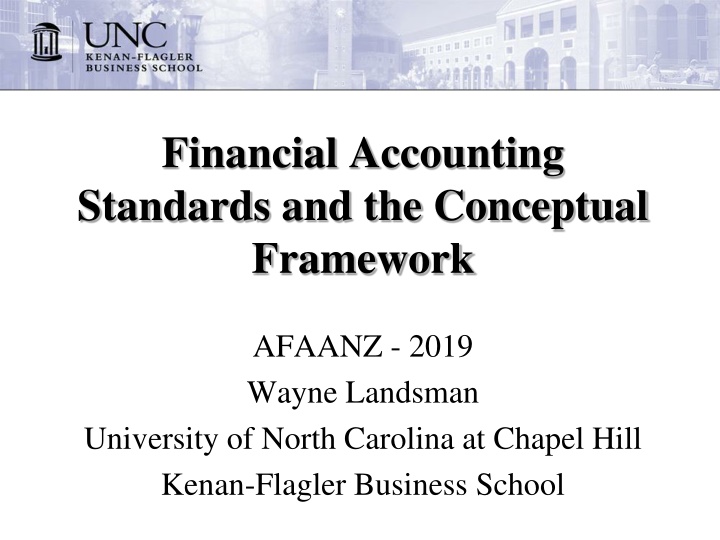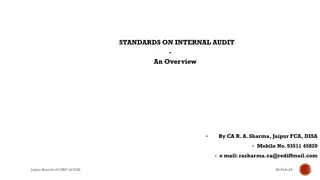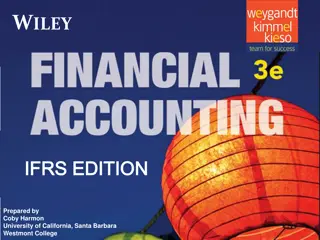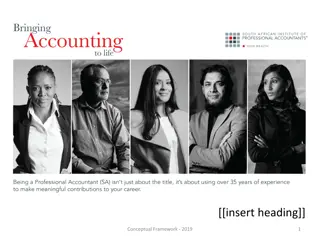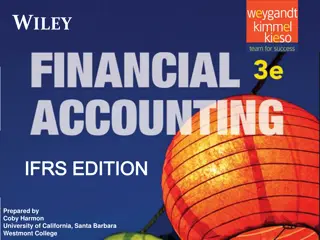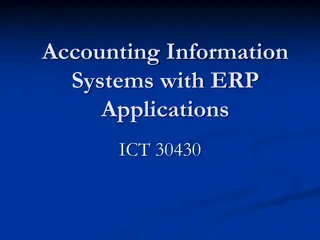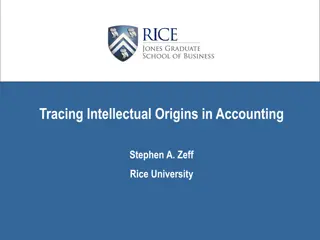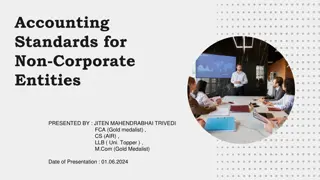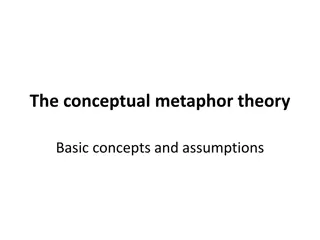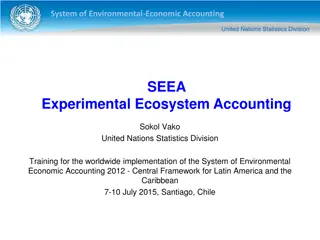Financial Accounting Standards & Conceptual Framework
The objectives, qualitative characteristics, and elements of financial statements in Accounting Standards, including insights on employee stock options. Understand the importance of providing relevant, verifiable, and understandable financial information to investors and creditors.
Uploaded on Mar 07, 2025 | 2 Views
Download Presentation

Please find below an Image/Link to download the presentation.
The content on the website is provided AS IS for your information and personal use only. It may not be sold, licensed, or shared on other websites without obtaining consent from the author.If you encounter any issues during the download, it is possible that the publisher has removed the file from their server.
You are allowed to download the files provided on this website for personal or commercial use, subject to the condition that they are used lawfully. All files are the property of their respective owners.
The content on the website is provided AS IS for your information and personal use only. It may not be sold, licensed, or shared on other websites without obtaining consent from the author.
E N D
Presentation Transcript
Financial Accounting Standards and the Conceptual Framework AFAANZ - 2019 Wayne Landsman University of North Carolina at Chapel Hill Kenan-Flagler Business School
Financial Accounting Standards and the Conceptual Framework Objective Provide financial information about the reporting entity that is useful to existing and potential investors, lenders, and other creditors in making decisions about providing resources to the entity.
Financial Accounting Standards and the Conceptual Framework Qualitative characteristics of Useful Financial Information Financial information must be relevant and Faithfully represent what it purports to represent. The usefulness of financial information is enhanced if it is Comparable Verifiable Timely Understandable.
Financial Accounting Standards and the Conceptual Framework Elements of Financial Statements Assets Liabilities Equity or net assets Comprehensive Income Revenues Expenses Gains Losses
Case 1: Employee stock options Case 1, Employee stock options (ESO) IFRS 2 and SFAS 123 Landsman, Wayne R., et al. "Which approach to accounting for employee stock options best reflects market pricing?." Review of Accounting Studies (2006).
Case 1: Employee stock options APB 25 do nothing method: At exercise: Dr. Cash Cr. Stock, Par value (PAR) Cr. Additional Paid in Capital (APIC) OR Cr. Treasury shares (TIC)
Case 1: Employee stock options Exposure draft method: Grant date: Dr. ESO Asset (Intangible asset) Cr. Equity (PIC ESO s) Throughout vesting period: Dr. ESO compensation expense Cr. ESO Asset At exercise: Dr. Cash Dr. PIC ESOs Cr. Par, APIC (or TS)
Case 1: Employee stock options FAS 123R/IFRS 2: Grant date: Do nothing Throughout vesting period: Dr. ESO compensation expense Cr. PIC - ESOs At exercise: Dr. Cash Dr. PIC ESOs Cr. Par, APIC (or TS)
Case 1: Employee stock options Asset and liability method: Grant date: Dr. ESO Asset (Intangible asset) Cr. ESO Liability Throughout vesting period: Dr. ESO compensation expense Cr. ESO Asset AND Dr. Loss Cr. ESO Liability Dr. ESO Liability Cr. Gain OR
Case 1: Employee stock options Asset and liability method: At exercise: Dr. Cash Dr. ESO Liability Cr. Par, APIC (or TS)* * Will be recognized at FV because ESO liability is at FV
Case 2: Leases Case 2, Leases SFAS 13, ASC 842, and IFRS 16 Bowman, Robert G. "The debt equivalence of leases: An empirical investigation." Accounting Review (1980).
Case 2: Leases Requirements for capital lease treatment: Capital lease treatment is required if the lease is noncancelable and at least one of the four conditions is met: The lease transfers ownership to the lessee. The lease contains a bargain purchase option. The lease term is equal to 75% or more of the estimated useful life of the leased asset. The present value of the minimum lease payments equals or exceeds 90% of the fair value of the leased property.
Case 2: Leases Spencer and Webb (2015) cites an SEC study from 2005 that notes the following: estimated that while 22 percent of issuers report capital leases totaling approximately $45 billion (undiscounted), 63 percent of issuers report off-balance sheet operating leases totaling approximately $1.25 trillion (undiscounted). Spencer, Angela Wheeler, and Thomas Z. Webb. "Leases: A review of contemporary academic literature relating to lessees." Accounting Horizons (2015).
Case 2: Leases AAG Contractual Obligations The following table provides details of our future cash contractual obligations as of December 31, 2015. The table does not include commitments that are contingent on events or other factors that are uncertain or unknown at this time. Payments Due by Period 2021 and Thereafter American Debt and capital lease obligations (1), (3) Interest obligations (2), (3) Commitments for aircraft and engine purchases (4) Operating lease commitments (5) Regional capacity purchase agreements (6) Minimum pension obligations (7) Retiree medical and other purchase obligations (7) Total American Contractual Obligations $ 2,266 $ 1,598 $1,634 $ 2,628 796 742 4,505 4,591 2,916 3,156 2,187 2,069 1,824 1,642 1,672 1,553 1,249 1,075 435 241 $11,861 $10,794 $8,691 $10,485 2018 2016 2017 2019 2020 Total $ 3,081 472 2,793 1,493 881 902 $ 9,712 $ 7,820 1,314 4,537 4,704 2,393 4,199 355 $25,322 $19,027 4,623 22,498 13,919 8,823 6,470 1,505 $76,865 698 601 164 1,205 206 178 90 AAG Parent and Other AAG Subsidiaries Debt and capital lease obligations (1) Interest obligations (2) Operating lease commitments Total AAG Contractual Obligations $ $11,969 $10,900 $9,278 $11,303 $ 97 11 $ 500 $ 97 9 750 67 1 $ $10,232 506 14 $ $25,355 24 9 $ 1,780 366 $79,037 82 5 26
Case 2: Leases https://www.pwc.com/us/en/cfodirect/assets/pdf/accounting-guides/pwc-lease-accounting-guide.pdf
Case 3: Asset securitizations Case 3, Asset securitizations SFAS 144, 166, IAS 39, and SIC 12
Case 3: Asset securitizations Transfer to entity unrelated to the firm (record as sale): Dr. Cash Cr. Transferred assets Cr. Gain (or Dr. Loss) Transfer to entity controlled by the firm (record as loan): Dr. Cash Cr. Debt
Case 3: Asset securitizations US Rules Before the Financial Crisis (BFC) Sale accounting permitted if: S-O legally relinquished control (title transfer and no explicit repurchase agreements) SPE had at least 3% equity S-O owned less than a majority stake in the equity
Case 3: Asset securitizations Landsman, Peasnell, and Shakespeare (TAR 2008) finds evidence that investors value S-O bank equity as if SPE assets and liabilities are assets and liabilities of the bank. Landsman, Wayne R., Kenneth V. Peasnell, and Catherine Shakespeare. "Are asset securitizations sales or loans?." The Accounting Review (2008).
Case 3: Asset securitizations After Financial Crisis: Qualified SPEs effectively eliminated. Effectively, this means that many more SPEs accounts must be consolidated with S-Os . Tightens up consolidation requirements for Variable Interest Entities (an SPE structure).
Case 3: Asset securitizations After Financial Crisis: Additional disclosures are required by the S-O, including Nature and purpose of SPE or VIE. Whether changes in financing of SPE by S-O have occurred subsequent to set-up of SPE. Fair value of financial assets and liabilities of SPE. Arrangements that could require the S-O to provide financial support to VIE, including events or circumstances that could expose the enterprise to a loss. Consolidation rule changes went into effect 2010, but disclosures were required beginning 4th quarter 2008.
